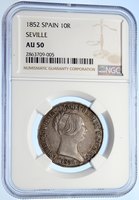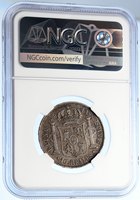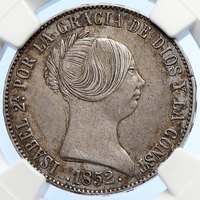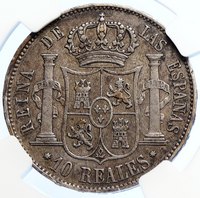Spain under Isabella - Queen: 29 September 1833 – 30 September 1868
1852 Silver 10 Reales 29mm (12.68 grams) 0.900 Silver (0.3804 ASW)
Reference: KM# 595.1, Cal# 206 (1851*-1855)
Certification: NGC AU 50 2863709-005
ISABEL 2A POR LA GRACIA DE DIOS Y LA CONST .., Isabella facing right.
REINA DE LAS ESPANAS *10 REALES*, Crowned shield with castles and lions.
Edge Lettering:
* I ** LEY. I PATRIA. I REY.
You are bidding on the exact item pictured, provided with a Certificate of Authenticity and Lifetime Guarantee of Authenticity.
You are bidding on the exact item pictured, provided with a Certificate of Authenticity and Lifetime Guarantee of Authenticity.
 Isabella II (Spanish: Isabel; 10 October 1830 - 9 April 1904) was Queen of Spain from 1833 until 1868. She came to the throne as an infant, but her succession was disputed by the Carlists, whose refusal to recognize a female sovereign led to the Carlist Wars. After a troubled reign, she was deposed in the Glorious Revolution of 1868, and formally abdicated in 1870. Her son, Alfonso XII, became king in 1874. Isabella II (Spanish: Isabel; 10 October 1830 - 9 April 1904) was Queen of Spain from 1833 until 1868. She came to the throne as an infant, but her succession was disputed by the Carlists, whose refusal to recognize a female sovereign led to the Carlist Wars. After a troubled reign, she was deposed in the Glorious Revolution of 1868, and formally abdicated in 1870. Her son, Alfonso XII, became king in 1874.
Birth and regency Isabella was born in Madrid in 1830, the eldest daughter of King Ferdinand VII of Spain, and of his fourth wife and niece, Maria Christina of the Two Sicilies. Queen Maria Christina became regent on 29 September 1833, when her three-year-old daughter Isabella was proclaimed sovereign on the death of the king. Isabella succeeded to the throne because Ferdinand VII had induced the Cortes Generales to help him set aside the Salic law, introduced by the Bourbons in the early 18th century, and to reestablish the older succession law of Spain. The first pretender to the throne, Ferdinand's brother Infante Carlos, Count of Molina, fought seven years during the minority of Isabella to dispute her title. Carlos' and his descendants' supporters were known as Carlists, and the fight over the succession was the subject of a number of Carlist Wars in the 19th century. Isabella's reign was maintained only through the support of the army. The Cortes and the Moderate Liberals and Progressives reestablished constitutional and parliamentary government, dissolved the religious orders and confiscated their property (including that of the Jesuits), and tried to restore order to Spain's finances. After the Carlist war, the regent, Maria Christina, resigned to make way for Baldomero Espartero, Prince of Vergara, the most successful and most popular Isabelline general. Espartero, a Progressive, remained regent for only two years. Baldomero Espartero was turned out in 1843 by a military and political pronunciamiento led by Generals Leopoldo O'Donnell and Ramón María Narváez. They formed a cabinet, presided over by Joaquín María López y López. This government induced the Cortes to declare Isabella of age at 13. Marriage Three years later, on 10 October 1846, the Moderate Party (or Castilian Conservatives) made their sixteen-year-old queen marry her double-first cousin Francisco de Asís de Borbón (1822-1902), the same day that her younger sister, infanta Luisa Fernanda, married Antoine d'Orléans, Duke of Montpensier. The marriages suited France and Louis Philippe, King of the French, who as a result bitterly quarrelled with Britain. However, the marriages were not happy; persistent rumour had it that few if any of Isabella's children were fathered by her king-consort, rumoured to be a homosexual. The Carlist party asserted that the heir-apparent to the throne, who later became Alfonso XII, had been fathered by a captain of the guard, Enrique Puigmoltó y Mayans. Isabella had nine children, but only five reached adulthood: - Ferdinand (1850)
- Isabel (1851-1931), Princess of Asturias, who married her mother's and father's first cousin Prince Gaetan, Count of Girgenti.
- María Cristina (1854)
- Alfonso XII (1857-1885)
- María de la Concepcion (1859-1861)
- María del Pilar (1861-1879)
- María de la Paz (1862-1946), who married her cousin Prince Ludwig Ferdinand of Bavaria.
- Francisco de Asís (1863)
- Eulalia de Asís de la Piedad (1864-1958), who married her cousin Infante Antonio, Duke of Galliera.
The couple was rather caustically described by an English contemporary thus: ... The Queen is large in stature, but rather what might be called bulky than stately. There is no dignity either in her face or figure, and the graces of majesty are altogether wanting. The countenance is cold and expressionless, with traces of an unchastened, unrefined, and impulsive character, and the indifference it betrays is not redeemed by any regularity or beauty of feature.The King Consort is much smaller in figure than his royal two-thirds, and certainly is not a type that could be admired for its manly qualifications; but we have to remember that in Spain aristocratic birth is designated rather by a diminutive stature and sickly complexion than by those attributes of height, muscular power, open expression, and florid hue, which in England constitute the ideal of 'race.' Isabella ruled directly from 1843 to 1868, a period marked by palace intrigues, back-stairs and antechamber influences, barracks conspiracies, and military pronunciamientos to further the ends of the political parties; Moderados ruled from 1846 to 1854, Progressives from 1854 to 1856, and Unión Liberals from 1856 to 1863. Moderados and Unión Liberals quickly succeeded each other to keep out the Progressives, thus sowing the seeds for the Revolution of 1868. Queen Isabella II often interfered in politics. She showed favour to her reactionary generals and statesmen and to the Church and religious orders. Spain fought two wars during her reign: the war against Morocco in 1859, which ended in a treaty advantageous for Spain and cession of some Moroccan territory, and the fruitless Chincha Islands War (1864-1866) against Peru and Chile. Her reign saw tensions with the United States over the Amistad affair and over the war in the Pacific; independence revolts in Cuba and Puerto Rico; and some progress in public works, especially railways, and a slight improvement in commerce and finance. By virtue of a royal decree, she opened Iloilo in the Philippines to world trade on September 29, 1855, mainly to export sugar and other products to America, Australia and Europe. Exile and abdication At the end of September 1868, the defeat of Isabella's forces at the Battle of Alcolea led to her deposition and exile to France. The revolt against Isabella played out in the battle is known as the Glorious Revolution. In 1870, the provisional government replaced Isabella with Amadeo I, second son of Victor Emmanuel II of Italy, after much deliberation. Amadeo's abdication under pressure in 1873 led to the period of the First Spanish Republic (1873-74). Isabella's exile helped cause the Franco-Prussian War, as Napoleon III could not accept the possibility that a German whose candidacy was supported by Prussia, Prince Leopold of Hohenzollern-Sigmaringen, might replace Isabella, a dynast of the Spanish Bourbons and great-great-granddaughter of the French-born Philip V of Spain. Napoleon III's loss in the war led to his deposition and the permanent end of monarchical government in France. The First Spanish Republic collapsed in December 1874. Already on 25 June 1870, Isabella had been induced to abdicate in Paris in favour of her son, Alfonso XII, a move that aided the cause of the Restoration in 1874. After the collapse of the Republic, Alfonso was placed on the throne. Isabella had left her husband in March 1874 and continued to live in France after the Restoration surrounded by a small circle of retainers with the Marqués de Alta Villa as her secretary. On the occasion of one of her visits to Madrid during the reign of Alfonso XII, she began to intrigue with politicians in the capital and was peremptorily requested to go abroad again. She lived in Paris for the rest of her life, residing at the Palacio Castilla. She seldom travelled abroad except for a few visits to Spain. During her exile, she grew closer to her husband, with whom she maintained an ambiguous friendship until his death in 1902. Her last days were marked by the marital problems of her youngest daughter, Eulalia. She died on 10 April 1904 and is entombed in El Escorial.
  Spain, officially the Kingdom of Spain (Spanish: Reino de España), is a country mostly located on the Iberian Peninsula in Europe, with there also being two large archipelagoes, the Balearic Islands in the Mediterranean Sea and the Canary Islands off the African Atlantic coast, two cities, Ceuta and Melilla, on the African mainland and several small islands in the Alboran Sea near the African coast. The country's mainland is bordered to the south and east by the Mediterranean Sea except for a small land boundary with Gibraltar; to the north and northeast by France, Andorra, and the Bay of Biscay; and to the west and northwest by Portugal and the Atlantic Ocean. It is the only European country to have a border with an African country (Morocco) and its African territory accounts for nearly 5% of its population, mostly in the Canary Islands but also in Ceuta and Melilla. Spain, officially the Kingdom of Spain (Spanish: Reino de España), is a country mostly located on the Iberian Peninsula in Europe, with there also being two large archipelagoes, the Balearic Islands in the Mediterranean Sea and the Canary Islands off the African Atlantic coast, two cities, Ceuta and Melilla, on the African mainland and several small islands in the Alboran Sea near the African coast. The country's mainland is bordered to the south and east by the Mediterranean Sea except for a small land boundary with Gibraltar; to the north and northeast by France, Andorra, and the Bay of Biscay; and to the west and northwest by Portugal and the Atlantic Ocean. It is the only European country to have a border with an African country (Morocco) and its African territory accounts for nearly 5% of its population, mostly in the Canary Islands but also in Ceuta and Melilla.
.svg/85px-Escudo_de_España_(mazonado).svg.png) With an area of 505,990 km2 (195,360 sq mi), Spain is the largest country in Southern Europe, the second largest country in Western Europe and the European Union, and the fourth largest country in the European continent. By population, Spain is the sixth largest in Europe and the fifth in the European Union. Spain's capital and largest city is Madrid; other major urban areas include Barcelona, Valencia, Seville, Bilbao and Málaga. With an area of 505,990 km2 (195,360 sq mi), Spain is the largest country in Southern Europe, the second largest country in Western Europe and the European Union, and the fourth largest country in the European continent. By population, Spain is the sixth largest in Europe and the fifth in the European Union. Spain's capital and largest city is Madrid; other major urban areas include Barcelona, Valencia, Seville, Bilbao and Málaga.
Modern humans first arrived in the Iberian Peninsula around 35,000 years ago. Iberian cultures along with ancient Phoenician, Greek and Carthaginian settlements developed on the peninsula until it came under Roman rule around 200 BCE, after which the region was named Hispania, based on the earlier Phoenician name Sp(a)n or Spania. At the end of the Western Roman Empire the Germanic tribal confederations in migration from Central Europe invaded the Iberian peninsula and established themselves in relatively independent realms in its western provinces, including the Sueves, Alans and Vandals. Eventually, the Visigoths would integrate by force all remaining independent territories in the peninsula, including Byzantine provinces into the Kingdom of Toledo that more or less unified politically, ecclesiastically and legally all the former Roman provinces or successor kingdoms of what was then known in documents as Hispania. The Visigothic kingdom fell to the Moors except in the north where shortly after started a process known as Reconquista. Spain emerged as a unified country in the 15th century under the Catholic Monarchs, who completed the eight centuries-long Reconquista in 1492. In the early modern period, Spain became one of history's first global empires, leaving a vast cultural and linguistic legacy that includes over 500 million Hispanophones, making Spanish the world's second most spoken native language, after Mandarin Chinese. Spain is a parliamentary democracy and constitutional monarchy, with King Felipe VI as head of state. It is a major developed country with the world's fourteenth largest economy by nominal GDP and sixteenth largest by purchasing power parity. It is a member of the United Nations (UN), the European Union (EU), the Eurozone, the Council of Europe (CoE), the Organization of Ibero-American States (OEI), the Union for the Mediterranean, the North Atlantic Treaty Organization (NATO), the Organisation for Economic Co-operation and Development (OECD), OSCE, the Schengen Area, the World Trade Organization (WTO) and many other international organisations. Spain has a "permanent invitation" to the G20 summits that occur generally once a year.
|




 Isabella II (Spanish: Isabel; 10 October 1830 - 9 April 1904) was Queen of Spain from 1833 until 1868. She came to the throne as an infant, but her succession was disputed by the Carlists, whose refusal to recognize a female sovereign led to the Carlist Wars. After a troubled reign, she was deposed in the Glorious Revolution of 1868, and formally abdicated in 1870. Her son, Alfonso XII, became king in 1874.
Isabella II (Spanish: Isabel; 10 October 1830 - 9 April 1904) was Queen of Spain from 1833 until 1868. She came to the throne as an infant, but her succession was disputed by the Carlists, whose refusal to recognize a female sovereign led to the Carlist Wars. After a troubled reign, she was deposed in the Glorious Revolution of 1868, and formally abdicated in 1870. Her son, Alfonso XII, became king in 1874. 
 Spain, officially the Kingdom of Spain (Spanish: Reino de España), is a country mostly located on the Iberian Peninsula in Europe, with there also being two large archipelagoes, the Balearic Islands in the Mediterranean Sea and the Canary Islands off the African Atlantic coast, two cities, Ceuta and Melilla, on the African mainland and several small islands in the Alboran Sea near the African coast. The country's mainland is bordered to the south and east by the Mediterranean Sea except for a small land boundary with Gibraltar; to the north and northeast by France, Andorra, and the Bay of Biscay; and to the west and northwest by Portugal and the Atlantic Ocean. It is the only European country to have a border with an African country (Morocco) and its African territory accounts for nearly 5% of its population, mostly in the Canary Islands but also in Ceuta and Melilla.
Spain, officially the Kingdom of Spain (Spanish: Reino de España), is a country mostly located on the Iberian Peninsula in Europe, with there also being two large archipelagoes, the Balearic Islands in the Mediterranean Sea and the Canary Islands off the African Atlantic coast, two cities, Ceuta and Melilla, on the African mainland and several small islands in the Alboran Sea near the African coast. The country's mainland is bordered to the south and east by the Mediterranean Sea except for a small land boundary with Gibraltar; to the north and northeast by France, Andorra, and the Bay of Biscay; and to the west and northwest by Portugal and the Atlantic Ocean. It is the only European country to have a border with an African country (Morocco) and its African territory accounts for nearly 5% of its population, mostly in the Canary Islands but also in Ceuta and Melilla..svg/85px-Escudo_de_España_(mazonado).svg.png) With an area of 505,990 km2 (195,360 sq mi), Spain is the largest country in Southern Europe, the second largest country in Western Europe and the European Union, and the fourth largest country in the European continent. By population, Spain is the sixth largest in Europe and the fifth in the European Union. Spain's capital and largest city is Madrid; other major urban areas include Barcelona, Valencia, Seville, Bilbao and Málaga.
With an area of 505,990 km2 (195,360 sq mi), Spain is the largest country in Southern Europe, the second largest country in Western Europe and the European Union, and the fourth largest country in the European continent. By population, Spain is the sixth largest in Europe and the fifth in the European Union. Spain's capital and largest city is Madrid; other major urban areas include Barcelona, Valencia, Seville, Bilbao and Málaga.
